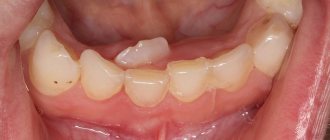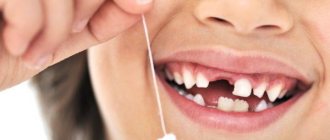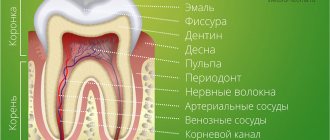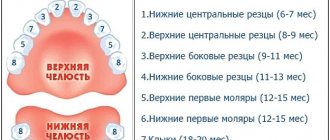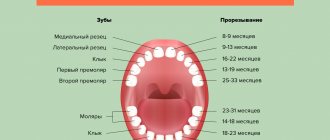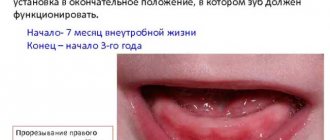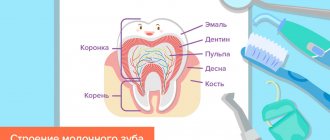The formation of teeth is a complex step-by-step process that begins in the first weeks of intrauterine life. Thus, by the time of birth, the baby has the rudiments of 20 primary and 16 permanent teeth inside each jaw. But, like all stages of development, teething in children under one year and older occurs differently. Some endure this period relatively calmly, others are capricious and sleep poorly. Why this happens and how to understand that the baby is cutting teeth, we will tell you further.
Timing of teething in children
On average, the first teeth in healthy children appear at 5–6 months. But sometimes it happens that someone has a white bump visible at 4 months, and someone smiles with a toothless mouth even at 8-12 months. And this is not a deviation from the norm. According to studies by a number of authors, the timing differs depending on the region of residence, race, and gender of the child. For example, children in the southern regions develop teeth a little earlier than those in the north. The formation of temporary teeth is also influenced by the following factors:
- heredity;
- maternal toxicosis in the second and third trimester of pregnancy;
- prematurity;
- artificial feeding;
- quality of drinking water;
- hypothyroidism and other endocrine pathologies;
- infectious diseases;
- weakened immunity;
- rickets.
It is impossible to speed up the timing and influence the sequence of teething in children. The only thing parents can do at this time is to alleviate the baby’s condition if he is restless and in pain (more on this below).
Baby's first teeth: when to expect?
Most babies erupt their first tooth between the fifth and eighth month of life. Breastfed children usually develop teeth several weeks earlier than formula-fed or formula-fed children. This is due to the fact that most infants receive breastfeeding “on demand,” and frequent and prolonged breastfeeding stimulates rapid thinning of the gum tissue through which the top of the tooth erupts.
During teething, the baby puts everything in his mouth
In children who receive breast milk substitutes as their main diet, their first teeth erupt at the age of 6-8 months. If the baby is already 8-9 months old and still has no teeth, there is no need to panic: late teething in some cases is a variant of the physiological norm and may depend on several factors, including:
- density of gum tissue at the site of eruption;
- time of introduction of complementary foods and composition of the children's diet;
- climatic conditions in the region of residence;
- the presence of chronic diseases and metabolic disorders.
Late teething occurs when teeth are retained in the jaw or alveolar ridge.
Of great importance in the timing of teething and in infants is the supply of essential minerals necessary for the health of bone tissue - calcium, phosphorus, iron and fluorine. If a child has endocrine disorders, the absorption and assimilation of these elements may be impaired, therefore, if the child is missing at least one tooth by 10-12 months, it is necessary to consult a specialist.
First tooth
Note! A hereditary factor can also influence the time of eruption of baby teeth, especially in the female line. If the mother or grandmother of the baby has teeth later than the established physiological norms, the probability of late teething in the child will be about 30%.
Subsequence
The order in which teeth appear may vary, which is rare and is not considered pathological. For some boys and girls, the upper incisors appear first, rather than the lower incisors as usual. But basically the sequence of teething in children is as follows (teeth appear in pairs):
- lower central incisors;
- upper central incisors;
- upper lateral incisors;
- lower lateral incisors;
- first upper molars (molars);
- first lower molars;
- upper canines;
- lower canines;
- second lower molars;
- second upper molars.
By the age of 2.5–3 years, the child has a full set of baby teeth: 10 on each jaw. After about 4–6 years, the roots begin to dissolve, the teeth lose support and fall out in the same order in which they erupted.
As the jaw and facial bones grow, spaces form between the primary teeth. This provides space for permanent, larger teeth to emerge, which erupt from 5 to 15 years of age.
When does a baby's first teeth erupt?
All babies cut their teeth according to their own individual program: for some this process begins earlier, for others later. As practice shows, most children have their first tooth between the ages of 6 and 8.5 months, and by the age of one year, every healthy child has at least one baby tooth in their mouth.
At the age of three to four months, the teeth that are preparing to erupt begin to make themselves known quite actively: the baby becomes capricious, cries, and tries to bite everything that falls into his hands.
The very first to appear are usually the two lower ones, located in the center of the tooth (lower central incisors or “ones”). Then - the central upper incisors, followed by approximately ten months of age, the upper “twos”, or lateral upper incisors, erupt. By eleven to twelve months, the lateral incisors can be seen on the lower jaw. Thus, ideally, a one-year-old child is the happy owner of eight baby teeth.
By about sixteen months, many babies already have their first molars at the bottom and top. Fangs (“threes”) appear above and below later, in the eighteenth to twenty-second months of a child’s life. The upper and lower second molars erupt between 24 and 33 months of age. But again, it should be remembered that this process is individual and the order of teething may also be different.
Often teeth grow in pairs: two, and sometimes four at a time. Girls generally erupt teeth earlier than boys. By the age of 2.5-3 years, a child can find a full set of twenty fully erupted teeth.
Caution must be exercised if a child who is almost one year old does not have a single tooth. In principle, some children may have a congenital feature in the form of late teething, but you should not draw any conclusions on your own; you should definitely consult with a qualified specialist who, if necessary, will prescribe additional examinations.
Causes of late teething in children:
- hereditary predisposition, which is a variant of the norm and can be traced in other blood relatives;
- decreased thyroid function;
- rickets;
- diseases of the digestive system;
- disorders of enzymatic (fermentation) metabolism;
- pituitary insufficiency;
- lack of calcium in the child’s body;
- genetically determined diseases.
For the baby himself, the process of teething can proceed in different ways. Some children experience virtually no discomfort, others suffer from pain, their sleep is disturbed, their appetite worsens, their temperature rises (up to 38-39̊C), salivation increases, they may experience nasal congestion, a wet cough (due to excessive salivation), constipation, or, conversely, , increased bowel movements.
Experts recommend starting to care for your child’s oral cavity even before the first teeth erupt: in the morning and evening, before going to bed at night, the child’s gums should be carefully wiped with a swab previously moistened with warm water. After the first teeth appear, you need to clean them with a special finger brush, which can also be used to massage the gum tissue. The front teeth should be brushed with vertical movements, the side teeth should be brushed in a circular motion.
The Healthy Smile network of dental clinics employs experienced pediatric dentists, with whom you can schedule your child for a free consultation.
The Healthy Smile clinics provide discounts for regular customers, family discounts, various payment methods are possible, and the list of promotional offers to reduce the cost of certain types of services, including for children, is regularly updated.
Symptoms
Usually, no serious problems arise during teething, but local (in rare cases systemic) disturbances are present. These include:
- swelling and soreness of the gums;
- profuse drooling;
- irritability;
- restless sleep;
- lethargy;
- the baby's need for biting and chewing;
- poor appetite.
Loose stools, low-grade fever and runny nose are less common than the above symptoms.
Important! If the body temperature rises above 38 degrees, convulsions, difficulty breathing, you need to show the baby to a doctor and call an ambulance. This may indicate a viral infectious disease and is not a sign of teething.
Some parents wonder why this process occurs differently in babies. For example, in some teething occurs with fever, in others it does not. It is noted that, among other factors, this is also influenced by the child’s constitutional type. In children of the allergic type, this period may be accompanied by increased moodiness, atopic dermatitis, and ARVI is often associated. Infants with asthenic syndrome sleep poorly, refuse to eat, and cry for a long time due to severe pain.
What are the symptoms of teething
Only some parents do not encounter difficulties with their child’s teething and notice the incisor by chance, not understanding when it appeared. In most cases, the process is accompanied by unpleasant symptoms:
- Swelling, “looseness” of the gums. Redness and bumps may form. Sometimes the teeth show through the gums. In some cases, there are bluish hematomas.
- Increased salivation. This may cause rashes around the mouth. But salivation at 2 months of age does not always indicate teething. During this period, such a process is physiological. If the rashes appear in other places, this is not related to teething.
- Restless state. The child cries a lot, is capricious, and the quality of his sleep deteriorates. Often the baby cannot be calmed down. Conventional methods (swinging, pacifiers, etc.) do not help.
- Increased body temperature. More often these are indicators up to 37.5 ˚C. This can happen due to local inflammation (of the gums). A higher temperature indicates viral activity.
- Loss of appetite. During the period of teething, children eat poorly or refuse to eat at all. Sometimes the baby cannot be put to the breast. Some babies kick their legs and arch when feeding.
- Runny nose and cough. Due to increased salivation, mucus flows down the back of the throat. It gets into the nasal passages, since the baby at the age of two months is more in a lying position. When mucus enters the throat, it provokes a cough. More often it appears during sleep.
Such symptoms do not occur all at once and can be combined in different ways. They often become a serious cause for concern for parents. Even the fact that a child is teething at such an early age is already shocking to them.
It is important not to confuse the signs of infectious or neurological diseases that have similar symptoms with the process of teething. Therefore, it is better to show the baby to the doctor. The following symptoms are also reasons to seek help: the child is very lethargic, has a high temperature (above +38 C), vomiting or mouth ulcers. A child may also vomit due to excessive salivation when mucus enters the stomach. Loose and frequent stools also indicate an infection. Diarrhea can cause dehydration.
How to help your baby teething
To eliminate unpleasant symptoms and make the child feel better, parents are advised to:
- Buy teethers made of silicone or special soft plastic filled with water. These devices are cooled to a comfortable temperature (not frozen) and given to the baby. Cold reduces pain in the gums and relieves swelling.
- Massage your gums. To do this, an adult needs to wrap his finger in a clean gauze swab, moisten it in cool boiled water and lightly massage the inflamed area.
- Give ibuprofen or paracetamol if the child is very restless or has a high fever. The dosage is prescribed by the doctor.
Important! During teething, babies put everything in their mouth, which can cause a secondary infection. Therefore, parents need to carefully monitor oral hygiene, regularly wipe their face with a clean towel, and gently blot saliva.
As for special gels for gums, you need to be careful and not use them too often, as some components can cause an allergic reaction.
Timing of teething
One of the most common questions parents ask is: “How long does teething take for babies?” It is useful to know both the time frame for the appearance of the first tooth and the time frame for the eruption of all teeth. In general, teething is an ongoing process that occurs between 6 and 24 months of age. Although your baby has twenty baby teeth that will appear over the course of two years, teething fortunately only causes pain and irritation at the time the tooth is about to break through the gum. It is not known exactly how long it will take for a tooth to fully erupt, but on average experts say it can erupt within 1-7 days per tooth. However, teething symptoms usually only last a couple of days, so if your baby experiences discomfort for an extended period of time, it's safe to assume it's not teething.
Caring for baby teeth
You need to take care of your teeth immediately after teething. Moms do it first. For adults, special finger brushes have been created that are convenient for cleaning teeth from plaque, but so far without toothpaste. When the baby learns to rinse his mouth and spit, they move on to brushing with children's toothpaste without fluoride (this can be done earlier if the tube indicates that the toothpaste is from 0 years). So, gradually, the child will form a useful habit of caring for the oral cavity.
Another important reason for caring for teeth from infancy is that it affects the formation of permanent teeth and bite. For example, caries of a temporary tooth can transfer to the germ of a permanent one. And early loss (before 5 years) of a baby tooth will lead to uneven dentition in the future. If the molar does not begin to grow in time, the adjacent baby teeth will move and fill the resulting space.
What teeth will a child have after one year?
In the second year of life, the baby begins to erupt small chewing teeth and canines. Fangs are the sharpest teeth that are necessary for tearing food into small pieces. Eruption of fangs is considered the most painful process due to the very sharp surface, which severely injures soft tissues. You can understand that a child’s fangs are creeping by the following signs:
- Molars in children: order of eruption
- hyperemia of the mucous membranes;
- swelling of the gum tissue, severe swelling;
- temperature rise to 38.5 degrees;
- profuse drooling;
- a white lump that has an elongated and flattened shape.
Increased salivation in infants
A few months before the canines, the baby develops small molars (they are also called premolars). Their eruption is less painful and usually occurs unnoticed by parents. In some cases, the child may experience problems with appetite, pain when brushing teeth, and changeable mood. Pathological signs that some consider typical of the eruption process (runny nose, diarrhea) usually do not occur with the appearance of first and second premolars, but this depends on the individual threshold of pain sensitivity.
Table No. 2. Pattern of teething in the second year of life.
| Child's age | What teeth appear |
| First molars (chewing teeth) on the upper jaw | 1-1.5 years |
| First molars (chewing teeth) on the lower jaw | 14-20 months |
| Upper and lower canines | 1 year 3 months – 2 years |
| Second molars on the mandible | 20 months – 2.5 years |
By the end of the second year of life, a child should have about 16-18 teeth.
Important! Second molars on the upper jaw arch may appear before the child is two years old. In some children, the upper/lower dentition of primary teeth is completely formed by 23-24 months, but this happens quite rarely (no more than 5-7% of the total number of children).
Scheme of baby teeth eruption

